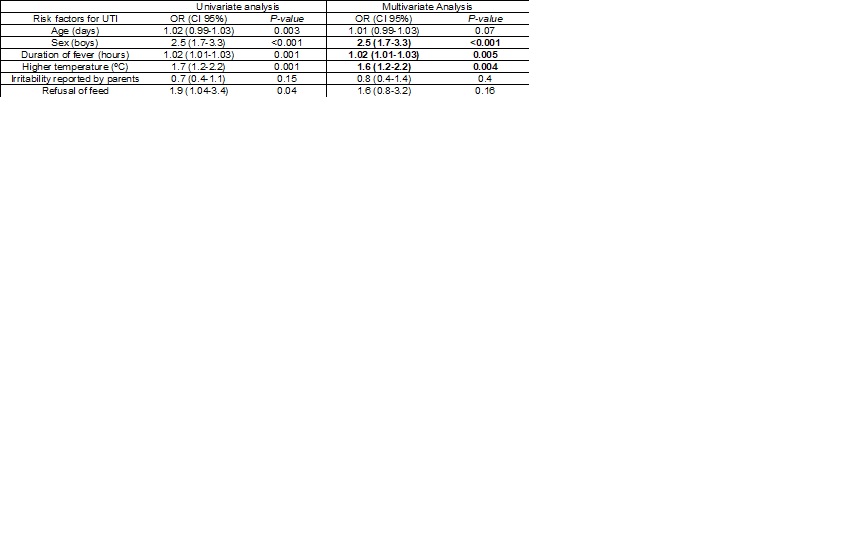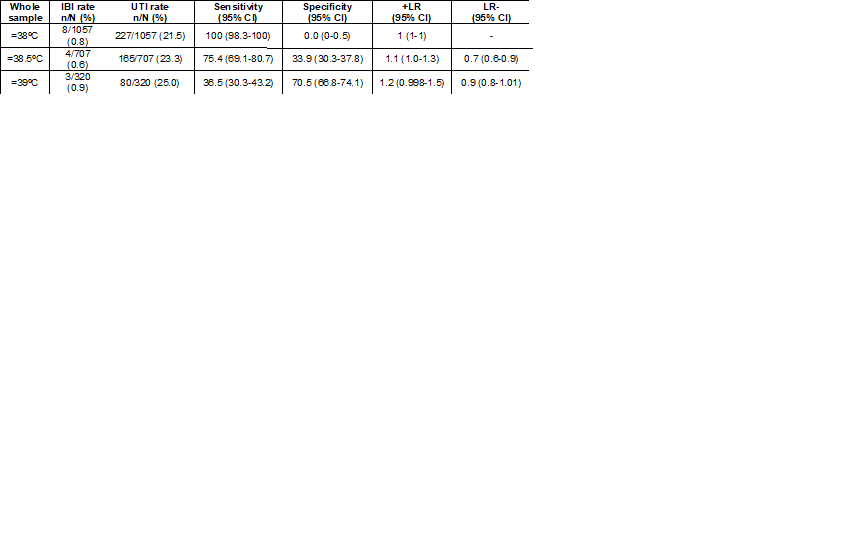Emergency Medicine
Session: Emergency Medicine 4: Infections
116 - Value of temperature for predicting urinary tract infection in febrile infants 61-90 days old
Saturday, May 4, 2024
3:30 PM - 6:00 PM ET
Poster Number: 116
Publication Number: 116.1312
Publication Number: 116.1312
.jpg)
José Antonio Alonso Cadenas (he/him/his)
Pediatric Emergency Physician
Pediatric Emergency Department. Niño Jesús University Hospital
Madrid, Madrid, Spain
Presenting Author(s)
Background: Urinary tract infection (UTI) is the most common serious bacterial infection in febrile infants ≤90 days of age. Different guidelines and clinical prediction rules give recommendations for febrile infants ≤60 days old, but many of them lack to give recommendations for febrile infants 61-90 days old.
Objective: To analyze the prevalence of UTI in well-appearing febrile infants 61-90 days old with fever without a source (FWS) and its relationship with the degree of fever.
Design/Methods: Sub-study of a bicentre retrospective study including infants ≤90 days old with FWS attended at 2 Spanish pediatric emergency departments (ED) between 2011 and 2022. We included all well-appearing infants 61-90 days old with FWS (axillary or rectal temperature ≥38ºC) in whom urine dipstick, urine culture (UC) obtained by a sterile method, and blood culture (BC) were performed. UTI was defined as a positive UC (growth of a single uropathogenic organism: ≥10 000 cfu/mL if collected by urethral catheterization or ≥100 000 cfu/mL if obtained by clean-catch technique) associating positive findings on urine dipstick (either leucocyte esterase or nitrite test). Invasive bacterial infection (IBI) was considered if a bacterial pathogen was isolated in blood or cerebrospinal fluid. We performed a univariate and multivariate analysis to identify risk factors for UTI, and we calculated the sensitivity, specificity, and positive and negative likelihood ratios of different temperature cutoff points for identifying UTI.
Results: Among 1238 well-appearing infants 61-90 days old, 1057 (85.4%) met the inclusion criteria and were included in this subanalysis. Overall, 283 infants (26.8%) had an altered urine dipstick and 227 (21.5%) were diagnosed with a UTI. Most commonly UTI-causing bacteria were E. coli (207, 91.2%), Klebsiella spp (7, 3.1%), and Enterobacter spp (5, 2.2%). Area under the receiver operating characteristic curve for temperature for predicting a UTI was 0.55 (95% CI 0.52-0.58). Table 1 contains univariate and multivariate analysis to identify UTI and table 2 shows the prevalence of IBI and UTI, and the performance of different temperature cutoff points for predicting UTIs.
Eight (0.8%) patients presented an IBI. All of them were bacteremia and six of them were secondary to a UTI. The prevalence of bacteremia in patients with UTI was 2.6% (6/227).
Conclusion(s): There is a greater risk of UTI at higher temperatures but performing urine dipstick should be recommended in infants 61-90 days of age with FWS ≥38ºC regardless of the degree of fever. Blood tests should also be considered in patients with an altered urine dipstick.


